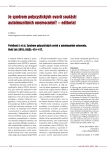Evaluation of cardiovascular high risk population in Specialists Ambulance: ESA
Authors:
J. Žižka 1; M. Souček 2
Authors‘ workplace:
I. interní klinika Fakultní Thomayerovy nemocnice a IPVZ Praha, přednosta doc. MU Dr. Štefan Alušík, Csc.
1; II. interní klinika Lékařské fakulty MU a FN u sv. Anny Brno, přednosta prof. MU Dr. Miroslav Souček, CSc.
2
Published in:
Vnitř Lék 2010; 56(5): 376-381
Category:
Original Contributions
Overview
Background:
Arterial hypertension is the most common CV disease in the Czech Republic with estimated prevalence 35% among population aged 25 to 64 years. Although serious public health problem with significant medical and economic consequences the treatment of HT is currently unsatisfactory. Only 18.4% of patients with arterial HT reach goal BP. There are several factors responsible for this fact, among them low compliance of patients, low dosages of antihypertensive drugs used and low usage of the combination of antihypertensive drugs.
Aim:
To obtain following data from the specialists ambulances (internists and cardiologists) regarding hypertensive patients: frequency of high risk hypertensive patients and proportion of patients with hypertension in whom BP is well controlled (target BP reached). Another goal of the study was to obtain data about pharmacological treatment of hypertensive patients.
Method:
National, multicenter, non‑interventional, cross sectional, representative sample, one visit study.
Results:
Data of 19,821 patients with primary hypertension visited office‑based internists and cardiologists was analysed. The average age was 64 ± 12 years (range 19 – 99 years), 53% was women. The mean blood pressure of entire population was 138.5 ± 15.1/ 81.7 ± 9.1 mm Hg. There were high proportion of patients with well controlled blood pressure (BP below 140/ 90 mm Hg) – 48% of the patients. Among those with diabetes the proportion of well controlled patients was much lower – only 11% of the patients. Regarding other cardiovascular risk factors the most common was hyperlipidaemia – 66% of the patients, following by diabetes and smoking with 29 and 14% of the patients respectively. 8,444 (43%) of the patients suffered from the coronary artery diseases, 2,251 (11%) patients have experienced stroke or TIA and 1,601 (8%) patients had peripheral artery disease. Regarding antihypertensive therapy, only 21% of the population was treated by monotherapy. The most common was the combination of ACE inhibitors plus beta‑blockers or triple - combination of ACE inhibitors plus diuretics plus beta‑blockers.
Key words:
arterial hypertension – risk factors – cardiovascular disease – pharmacotherapy
Sources
1. Widimský J Jr., Cífková R, Špinar J et al. Doporučení diagnostických a léčebných postupů u arteriální hypertenze – verze 2007. Cor Vasa 2008; 50: K5 – K22.
2. Cífková R. Stav kontroly hypertenze v ČR a ve světě. In: Widimský J et al (eds). Hypertenze. Praha: Triton 2008 : 563 – 557.
3. Hansson L, Zanchetti A, Carruthers SG et al. Effects of intensive blood - pressure lowering and low‑dose aspirin in patients with hypertension: principal results of the Hypertension Optimal Treatment (HOT) randomised trial. HOT Study Group. Lancet 1998; 351 : 1755 – 1762.
4. Widimský J, Sachová M, Souček M et al. Vysoká prevalence a špatná kontrola hypertenze v ordinacích praktických lékařů. Vnitř Lék 2005; 51 : 1087 – 1095.
5. Sharma AM, Wittchen HU, Kirch W et al. High prevalence and poor control of hypertension in primary care: cross ‑ sectional study. J Hypertens 2004; 22 : 479 – 486.
6. Jozífová M, Cífková R, Škodová Z et al. Porovnání léčby hypertenze a rizikového profilu hypertoniků v obecné populaci a na specializovaném pracovišti. Cor Vasa 2003; 45 : 533 – 541.
7. Jamerson K, Weber MA, Bakris GL et al. ACCOMPLISH Trial Investigators. Benazepril plus amlodipine or hydrochlorothiazide for hypertension in high‑risk patients. N Engl J Med 2008; 359 : 2417 – 2428.
8. Dahlöf B, Sever PS, Poulter NR et al. ASCOT Investigators. Prevention of cardiovascular events with an antihypertensive regiment of amlodipine adding perindopril as required versus atenolol adding bendroflumethiazide as required, in the Anglo-scandinavian Cardiac Outcomes Tria - Blood Pressure Lowering Arm (ASCOT ‑ BPLA): a multicentre randomized controlled trial. Lancet 2005; 366 : 895 – 906.
9. Wald DS, Law M, Morris JK et al. Combination therapy versus monotherapy in reducing blood pressure: meta‑analysis on 11 000 participants from 42 trials. Am J Med 2009; 122 : 290 – 300.
10. Patel A, MacMahon S, Chalmers J et al. ADVANCE Collaborative Group. Effects of a fixed combination of perindopril and indapamide on macrovascular and microvacular outcomes in patients with type 2 diabetes mellitus (the ADVANCE trial): a randomised controlled trial. Lancet 2007; 370 : 829 – 840.
11. Yusuf S, Teo KK, Pogue J et al. ONTARGET Investigators. Telmisartan, ramipril, or both in patients at high risk for vascular events. N Engl J Med 2008; 358 : 1547 – 1559.
12. Widimský J, Souček M, Sachová M et al. Hypertenze a diabetes mellitus v ordinacích praktických lékařů. Cor Vasa 2005; 47 : 127 – 132.
13. Mancia G, Laurent S, Agabiti ‑ Rosei L et al. Reappraisal of European guidelines on hypertension management: a European Society of Hypertension Task Force document. J Hypertens 2009; 27 : 2121 – 2158.
14. Widimský J. Komentář k přehodnocení evropských doporučení léčby arteriální hypertenze. Cor Vasa 2010; 52 : 75 – 78.
Labels
Diabetology Endocrinology Internal medicineArticle was published in
Internal Medicine

2010 Issue 5
Most read in this issue
- Familial hypercalcemia and hypophosphatemia: importance in differential diagnosis of disorders in calcium‑ phosphate metabolism
- A review of the effects of prolactin hormone and cytokine on the development and pathogenesis of autoimmune diseases
- Polycystic ovary syndrome and autoimmune diseases
- Hormonal contraception and risk of venous thromboembolism
